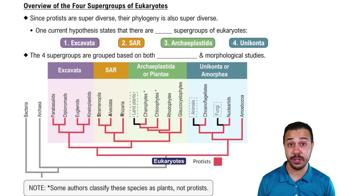Textbook Question
Which of the following characteristics of plants is absent in their closest relatives, the charophyte algae?
a. Chlorophyll b
b. Cellulose in cell walls
c. Sexual reproduction
d. Alternation of multicellular generations
1411
views
 Verified step by step guidance
Verified step by step guidance



Which of the following characteristics of plants is absent in their closest relatives, the charophyte algae?
a. Chlorophyll b
b. Cellulose in cell walls
c. Sexual reproduction
d. Alternation of multicellular generations
In plants, which of the following are produced by meiosis?
a. Haploid gametes
b. Diploid gametes
c. Haploid spores
d. Diploid spores
Microphylls are found in which plant group?
a. Lycophytes
b. Liverworts
c. Ferns
d. Hornworts